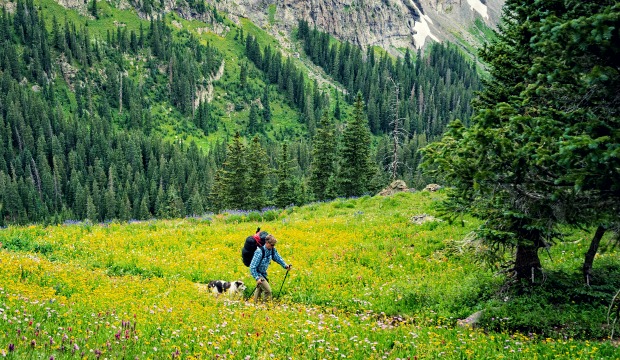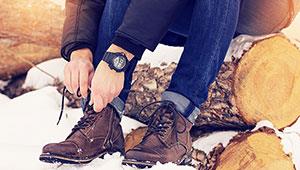
4. Make Sure Fido is Fit for the Trail
Very young dogs and very old dogs simply cannot handle the same trail length or intensity as other dogs. Be respectful of your dog’s limits and don’t push them to exhaustion. If you have any questions about how much is too much for your dog, ask your vet.
If you notice your dog lying down, panting intensely or foaming at the mouth, these are all signs they need to cool down, slow down and possibly turnaround. Just like you, dogs can gain or lose fitness. If during winter your dog got used to short walks around the snowy neighborhood, don’t expect them to be able to jump off the couch and hike 10 miles with you come springtime. Gradually build up the distance and intensity with your pet so they can enjoy the outdoors safely.
5. Consider a Pet First Aid Kit
Similar to small children, pets can easily get into mischief on a trail. Keeping a small first aid kit (whether it’s pet-specific or not) in your car or on your person can help you doctor any gashes, bites, sprains or burns your pup might get.
The Kurgo Pet First Aid Kit is less than $30 and offers everything you’d need should your pet get hurt on the trail. Remember, dogs can’t take the same pain medications as humans (for the most part), so if your dog is hurt and in pain you should always consult your vet.
6. Consider Rattlesnake Aversion Training
If you live anywhere in the Western United States and frequent the trails with your dog, rattlesnake aversion training should be something you seriously consider for your dog. The clinics generally last less than an hour, and they could save your dog’s life.
Aversion training can range from $75 to $300 depending on the method (most use shock training, others use more natural methods), and should be repeated every few years.
7. Dog Clothing is Silly—But Sometimes Necessary
Putting an argyle sweater on your dog so he looks fancy on the golf course is not what we’re talking about. If you have a shorthaired dog or a dog that spends the majority of their time indoors, they could benefit from an extra layer against wet and cold conditions.
Ruffwear sells a variety of excellent dog coats for breeds of all sizes. If, conversely, heat is the issue, you can also keep your dog cool by putting on a dog vest that has been soaked in cool water.
Most breeds can also benefit from dog booties (shoes for dogs) for cold, snowy trail conditions, but they are also helpful if you’re heading out on very hot sand or scrambling over rocks. And yes, most dogs hate them, but there’s nothing worse than seeing your dog in pain because they’ve torn up the bottom of their paws.
8. Keep an Eye Out for Anything Your Dog Ingests
Mushrooms, cattails, dog poop, pinecones, random socks—the list of things dogs can eat on a trail goes on and on. And some of it can be very dangerous—even deadly.
If you see your dog chewing on something, make sure you figure out what it is, and if it seems dangerous, take some of it with you to show your vet. This is especially important with plants and mushrooms. You can avoid a lot of these incidents by keeping your dog on leash, but if you go off-leash make sure you keep an eye on them so you know what they’re smelling and eating.
9. Always Do a Post-Hike Pup Check
While you’re experiencing the trails from five- to six-plus feet from the ground, your dog is running through knee-high brush and sweeping past all sorts of plants, bugs and burrs.
Always check your dog’s whole body for ticks, cuts, burrs and burns when you get back to your car. If you find a tick, remove it carefully and place it in a sealed bag to take to your vet. If you were out for quite a while and your dog got very dirty, a post-hike doggie bath is a good way to check for ticks and injuries and prevent skin allergies that pop up occasionally.
 Book your next hiking trip
Book your next hiking trip
- 2
- of
- 2



Discuss This Article